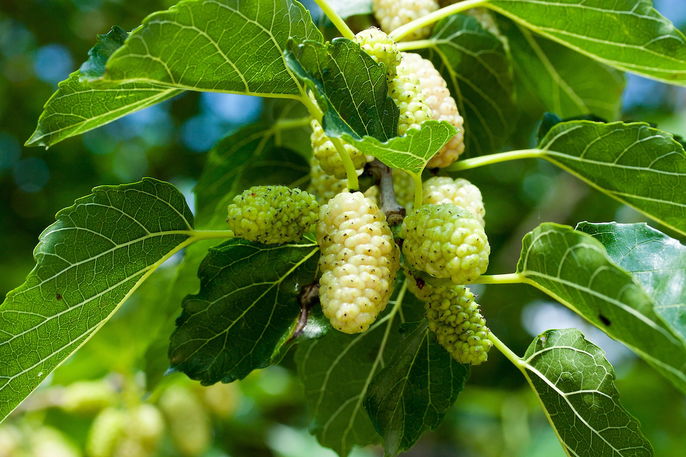White mulberry is a medicinal plant that is rich in flavonoids, alkaloids and phenolic acids. It contains anti-hyperglycemic, antioxidant and antimicrobial properties, and is therefore widely used to help treat diabetes, high blood pressure or arthritis.
White mulberry, scientifically known as Morus alba, houses most of its medicinal properties in its leaves, which is why they are used to prepare tea and formulate capsules. Furthermore, white mulberry fruit is also rich in nutrients, such as fiber, vitamin C and iron, and can be consumed fresh.
White mulberry can be purchased in health food stores, pharmacies and in some farmer's markets. It should be used for medical purposes as directed by a doctor or medicinal plant specialist.

Health benefits
White mulberry is normally used to help treat some health conditions, such as:
- Diabetes;
- High pressure;
- High cholesterol and triglycerides;
- Atherosclerosis;
- Colds;
- Arthritis;
- Muscle or joint pain;
- Bacterial or fungal infections, mainly in the mouth and genital region;
- Indigestion;
- Memory and concentration problems;
- Prevent premature aging;
- Weight loss.
The leaves contain the highest concentration of anti-hyperglycemic, antioxidant, anti-inflammatory, antimicrobial and astringent properties, however, consuming white mulberry fruits can also be beneficial.
Despite its many health benefits, white mulberry is not a substitute for medical treatment and should be used for medical purposes as directed by a doctor or medicinal plant specialist.
How to make white mulberry tea
The white mulberry leaf is the part that has the greatest therapeutic effects and, therefore, is the part of the plant that is normally used to prepare tea.
Ingredients
- 2 tablespoons of white mulberry leaves
- 200 mL of water
Directions
Boil the water, remove from heat and add the boiling water to the cup with the white mulberry leaves. Let it infuse for about 10 minutes. Then strain and drink up to 3 cups a day.
In addition to being consumed in tea form, white mulberry can also be consumed in powder form, where the recommended daily dose is around 500 mg, up to 3 times a day.
White mulberry can also be consumed in the form of capsules. Dosing depending on the concentration of white mulberry in the capsules, and should only be taken as directed by a doctor or medicinal plant specialist.
Possible side effects
White mulberry is considered safe for adults when taken within recommended doses for up to 4 weeks of treatment. However, when taken in high doses or for prolonged periods of time, it can cause side effects, such as diarrhea, constipation, dizziness or bloating.
Furthermore, white mulberry can greatly reduce blood pressure and interfere with blood pressure control in those taking antihypertensives. It can also reduce blood sugar levels and cause hypogylcemia in diabetics who are being treated with insulin or other antidiabetics.
Contraindications for use
White mulberry should not be used by children, pregnant or breastfeeding women, or by people who are allergic to this plant or birch pollen, or who have chronic diarrhea.
Furthermore, white mulberry should be used with caution by diabetics on insulin or anyone who takes antihypertensives for high blood pressure. In these cases, it should only be used if approved by a doctor.
Difference between black mulberry and white mulberry
The black mulberry and white mulberry are two different species of mulberries. While the white mulberry belongs to the species Morus alba, the black mulberry belongs to the species Morus nigra.
Although they may have some similar indications, such as treating high blood pressure and diabetes, the black mulberry, is rich in isoflavones, is also indicated to relieve symptoms of menopause.





























